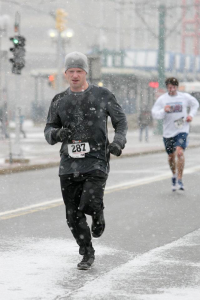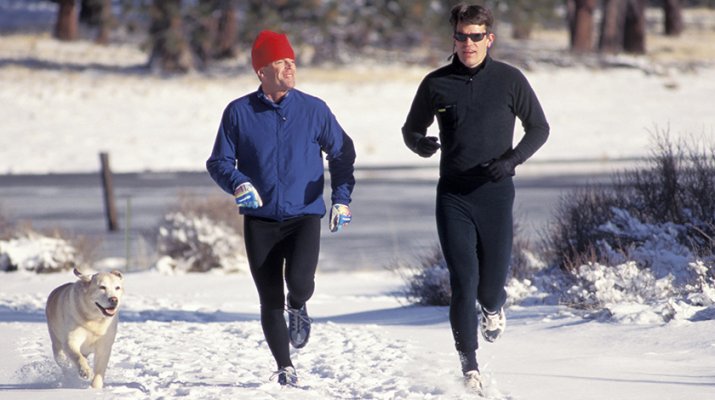Maintaining a running routine during the cold and snow. Yes, it’s possible
By Kyra Mancine
 For many runners, their running season ends when the cold, dark days of winter are upon us. For others, they continue running, even when the snow falls and temperatures tumble. How and why do they do it?
For many runners, their running season ends when the cold, dark days of winter are upon us. For others, they continue running, even when the snow falls and temperatures tumble. How and why do they do it?
It’s All About Attitude
Winter runners look at their outdoor runs as a chance to enjoy the beauty of the season. “I love running in the winter. I’ve always enjoyed the change of seasons,” said Matt Dow, who coaches high school cross-country, indoor and outdoor track at St. Joseph’s Institute in Buffalo, and has been a runner for more 30 years. “I would rather be a bit cold than hot. Once you start running, your body really does warm up quickly.”
It’s Better Than “The Dreadmill”
“Running indoors on a treadmill is so tedious to me — I can’t take it for more than a couple of miles,” Dow said. “I really enjoy going out in the cold, crisp air. I like the sound of the crunching snow, especially early in the morning when everything is still quiet.”
Molly LaPrade, an avid runner from Seneca Falls, echoed similar sentiments. “It doesn’t get any better than getting in a good run on a snowy winter day. Mentally, I need to get outside to get some fresh air. I also enjoy running in winter if the sun is out. I just check the temperature, and, if it’s not too cold, I‘m up for it. “
Be Prepared
It’s important to be ready for the conditions. Is it going to be windy? Is it slippery? What is the temperature going to be during the run? The answers to these questions dictate how you should dress.
Start off by wearing layers. Dow prepares by “wearing multiple layers on my legs and upper body. If it’s really snowy, I’ll throw on my trail shoes for a little extra traction.” LaPrade prepares by “always wearing a wicking material that is closest to my body. Then, I can take as many layers off as I need to feel comfortable.”
Be mindful to not overdress though, otherwise you risk overheating. You want to dress as if it’s 15 to 20 degrees warmer than it is outside. Fabrics that wick sweat are ideal, because they can vent moisture as you warm up during your run. You also want to make sure to wear a hat and protect your face from frostbite.
Expert Advice
Ellen Brenner, vice president of three Fleet Feet Sports in Buffalo, advises runners to cover all exposed skin, including neck, ears and even the ankles, which can easily be overlooked if you wear capris or three-quarter length running pants. “Stick to polyester or wool for your base layer — no cotton, which stays wet and can add to your chill. Even your underwear should be a fabric other than cotton.”

To help run in snow and icy conditions, Brenner recommends traction/cleat type devices (such as such as Yaktrax or STABILicers) that runners can slip on over their shoes. You can even have metal studs inserted into running shoes to help with traction and stability on snowy roads or trails. If snow is deep, trail shoes are recommended because they have deeper treads like a snow tire. Whatever footwear you choose, “don’t ignore the conditions — be logical,” Brenner said. “Runners still need to be cautious and shorten their stride, no matter what type of shoe they’re wearing. “
If you’re running early in the morning or at night, be sure and wear reflective or fluorescent gear, a headlamp or other attire with a light source. Some runners also run with flashlights. Remember, your phone doubles as one as well. There are many other products to make your outdoor run safe and more comfortable. Check out your local running store, and don’t be afraid to ask the staff for advice. Most of them are runners too!
Pre- and Post-Run
Besides being dressed appropriately, it’s also important to warm up before you start out. Being a bit chilly before a run is OK, but getting your heart rate up indoors (by doing a few jumping jacks or jumping rope for instance) before heading outdoors can help take away the initial shock of the cold to your system. In addition, changing out of sweaty, wet garments post run is extremely important. Having a hot beverage after a run is beneficial too and gives you something to look forward to as well.
Camaraderie counts
The bonding and team feeling that comes with engaging in the sport can be a big motivator for cold weather runners. If you’re looking for support and encouragement, Fleet Feet offers a free Winter Warrior ‘Winterventure’ program (Jan. 3 to Feb. 18), where runners collect points and track mileage through weekly workouts, special events and races. This program is intended to keep runners committed throughout the winter months. For more information, visit www.fleetfeetbuffalo.com/training/winter-warrior
Be Realistic
Don’t expect to be as fast as you are in warmer conditions. Accept that you aren’t going to beat any personal records. You never want to risk injury just to get a run in. And, yes, there will be times when the best choice is to skip that outdoor run.
With a little preparation and the right mindset though, outdoor running can be an invigorating way to enjoy the weather this winter.

